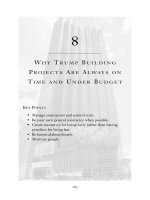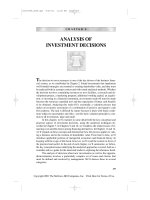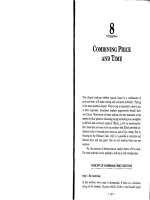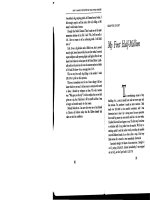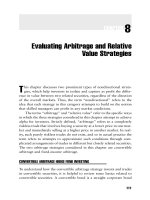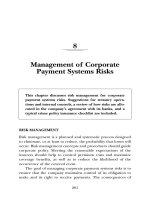Chapter 8 valuation
Bạn đang xem bản rút gọn của tài liệu. Xem và tải ngay bản đầy đủ của tài liệu tại đây (170.56 KB, 27 trang )
OPEN UNIVERSITY HCMC
MBA PREPARATORY COURSE
Principles of
Financial Accounting
Lecturer: NGUYEN TAN BINH
06/04/16
NGUYEN TAN BINH - PH
1
Chapter 8
Valuing and Accounting
for Bonds and Leases
06/04/16
NGUYEN TAN BINH - PH
2
Learning Objectives
After studying this chapter, you should be able to:
• Compute and interpret present and future
values.
• Value bonds using present value techniques.
• Account for bond issues over their entire life.
• Value and account for long-term lease
transactions.
• Evaluate pensions and other postretirement
benefits.
06/04/16
NGUYEN TAN BINH - PH
3
Valuing Long-Term Liabilities
• Long-term liabilities are more difficult to
value than short-term liabilities because of
the long time frames involved.
• Accountants use the time value of
money to value long-term liabilities.
– The time value of money refers to the fact that
a dollar you expect to pay or receive in the
future is not worth as much as a dollar you
have today.
06/04/16
NGUYEN TAN BINH - PH
4
Compound Interest, Future Value,
and Present Value
• When money is borrowed, the amount
borrowed is known as the loan principal.
– For the borrower, interest is the cost of using
the principal.
• Investing money is the same as making a
loan.
– The interest received is the return on the
investment.
06/04/16
NGUYEN TAN BINH - PH
5
Compound Interest, Future
Value, and Present Value
• Calculating the amount of interest depends on the
interest rate and the interest period.
• Types of interest:
– Simple interest - the interest rate multiplied by
an unchanging principal amount
– Compound interest - the interest rate
multiplied by a changing principal amount
• The unpaid interest is added to the principal
balance and becomes part of the new principal
balance for the next interest period.
06/04/16
NGUYEN TAN BINH - PH
6
Future Value
• Future value - the amount accumulated
over time, including principal and interest
– For example, if a person lets $10,000 sit in a
bank account that pays 10% interest per year
for 3 years, the future value of the $10,000 is
$13,310 and is determined as follows:
Year 1:
Year 2:
Year 3:
06/04/16
$10,000 x 1.10 = $11,000
$11,000 x 1.10 = $12,100
$12,100 x 1.10 = $13,310
NGUYEN TAN BINH - PH
7
Future Value
• The general formula for computing the
future value (FV) of S dollars in n years at
interest rate i is:
FV = S (1 + i )
n
n refers to the number of periods the funds are invested. The
interest rate must be stated consistently with the time period.
06/04/16
NGUYEN TAN BINH - PH
8
Future Value
• The calculations for future values can be
very tedious. Most people use future
value tables to determine future values.
– In the table, each number is the solution to the
expression (1 + i)n.
– The value of i is given in the column heading.
– The value of n is given in the row label for the
number of periods.
06/04/16
NGUYEN TAN BINH - PH
9
Future Value
To how much will $25,000 grow if left in
the bank for 20 years at 6% interest?
The answer is determined as follows:
$25,000 x 3.2071* = $80,177.50
*3.2071 is the future value factor for 20 periods at 6%
interest.
06/04/16
NGUYEN TAN BINH - PH
10
Present Value
• Present value - the value today of a future
cash inflow or outflow
• Present value calculations are the reverse
of future value calculations.
– In future value calculations, you determine
how much money you will have at a date in
the future given a certain interest rate.
– In present value calculations, you determine
how much must be invested today given a
certain interest rate to get to how much
money you want in the future.
06/04/16
NGUYEN TAN BINH - PH
11
Present Value
• For example, if $1.00 is to be received in
one year and the interest rate is 6%, you
will have to invest $0.9434 ($1.00 / 1.06).
– Thus, $0.9434 is the present value of $1.00 to
be received in one year at 6% interest.
06/04/16
NGUYEN TAN BINH - PH
12
Present Value
• The general formula for the present value
(PV) of a future value (FV) to be received
or paid in n periods at an interest rate of i
per period is:
FV
PV =
n
(1 + i )
06/04/16
NGUYEN TAN BINH - PH
13
Present Value
• Just as with future values, tables can be
helpful in determining the present value of
amounts.
– In the table, each number is the solution to the
expression 1/(1 + i)n.
– The value of i is given in the column heading.
– The value of n is given in the row label for the
number of periods.
06/04/16
NGUYEN TAN BINH - PH
14
Present Value
• Interest rates are sometimes called discount
rates in calculations involving present
values.
• Present values are also called discounted
values, and the process of finding the
present value is discounting.
– Present values can be thought of as decreasing
the value of a future cash inflow or outflow
because the cash is to be received or paid in the
future, not today.
06/04/16
NGUYEN TAN BINH - PH
15
Present Value
A city wants to issue $100,000 of noninterest-bearing bonds to be repaid in a
lump sum in 5 years. How much should
investors be willing to pay for the bonds if
they require a 10% return on their
investment?
$100,000 x .6209* = $62,090
*.6209 is the present value of $1 factor for 5 years at
10% interest.
06/04/16
NGUYEN TAN BINH - PH
16
Present Value
• Remember to pay attention to the number
of periods. Interest is often
compounded semiannually instead of
annually.
– If interest is compounded semiannually, the number
of periods is twice the number of years, and the
interest rate is one-half of the annual interest rate.
– In the previous example, if interest were compounded
semiannually, the number of periods is 10 instead of
5, and the interest rate is 5% instead of 10%.
06/04/16
NGUYEN TAN BINH - PH
17
Present Value of an
Ordinary Annuity
• Annuity - a series of equal cash flows to take place
during successive periods of equal length
• The present value of an annuity is the sum of the present
values of each cash receipt or payment.
– If a note has a series of payments, its present
value can be determined by finding the
present value of each payment and adding
those present values together.
06/04/16
NGUYEN TAN BINH - PH
18
Present Value of an
Ordinary Annuity
• Again, tables can be helpful in determining the present
value of an ordinary annuity.
• The factors in a present value of an annuity table are
merely the cumulative sum of the present value of $1
factors in the present value of $1 table for the number of
annuity periods.
– The present value of an ordinary annuity
tables are especially helpful if the cash
payments or receipts extend into the future
over many periods.
06/04/16
NGUYEN TAN BINH - PH
19
Present Value of an
Ordinary Annuity
A city wants to issue $1,000,000 of noninterest-bearing bonds to be repaid
$100,000 per year for 10 years. How
much should investors be willing to pay for
the bonds if they require a 10% return on
their investment?
$100,000 x 6.1446* = $614,460
*6.1446 is the present value of an annuity of $1 for 10
periods at 10% interest.
06/04/16
NGUYEN TAN BINH - PH
20
Present Value of an
Ordinary Annuity
• Notice that the higher the interest rate, the
lower the present value factor.
This occurs because at higher
interest rates, less must be
invested to obtain the same
stream of future annuity
payments or a certain amount in
the future.
06/04/16
NGUYEN TAN BINH - PH
21
Valuing Bonds
• Because bonds create cash flows in future
periods, they are recorded at the present
value of those future payments, discounted at
the market interest rate in effect when the
liability is created.
• Bond - formal certificate of indebtedness that
is typically accompanied by:
– A promise to pay interest in cash at a specified
annual rate plus
– A promise to pay the principal at a specific
maturity date
06/04/16
NGUYEN TAN BINH - PH
22
Valuing Bonds
• When valuing bonds, the present value tables
are used to determine the amount of proceeds
that will be received.
– The present value of $1 table is used to determine the
present value of the face amount of the bonds.
– The present value of an annuity of $1 is used to
determine the present value of the series of interest
payments.
– The amounts are added together to determine the
amount of proceeds and any premium or discount.
06/04/16
NGUYEN TAN BINH - PH
23
Valuing Bonds
A company issues $20,000,000 of 5-year
bonds with a coupon rate of 7%. Interest
is to be paid semiannually on June 30 and
December 31 of each year. At the time of
the issuance, the market rate is 10%.
What is the amount of the proceeds and
any premium or discount on the bonds?
06/04/16
NGUYEN TAN BINH - PH
24
Valuing Bonds
• To determine the proceeds:
$20,000,000 x .6139* = $12,278,000
$700,000‡ x 7.7217*
=
5,405,190
$17,683,190
($700,000 = ($20,000,000 x 7%) / 2)
*PV factors are for 10 periods at 5%
‡
The company will receive $17,683,190 upon issuance.
The bonds are issued at a discount of $2,316,810.
06/04/16
NGUYEN TAN BINH - PH
25

